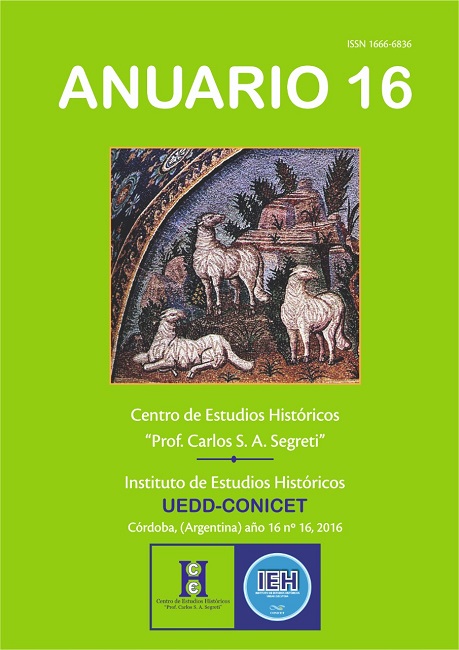The representation of the late-imperial bureaucratic elite in the missorium of Theodosius I - The codicilli to Materno Cynegio
DOI:
https://doi.org/10.52885/2683-9164.v0.n16.21993Keywords:
codicilii, Maternus Cynegius, Theodosius, missoriumAbstract
During the last decades, the late roman empire historiography has made significant advances in the knowledge of an era that had been eclipsed by the republican and high imperial roman history. However, the Theodosian period not only continues to conserve mysteries, but also the fascination on the figure and the sorroundings of the emperor Theodosius I. In 1847, a silver disc or missorium is found in the Spanish city of Almendralejo, representing a scene of the court of the emperor Theodosius. Later studies have shown that the richly engraved image is one of the most important moments in the political life of the empire: the commemoration of the emperor’s decennalia. Within this representation full of symbolism, one can observe the delivery, by the same Theodosius, of some codicilli to a high imperial official. Accepting the year 388 BC as a proposed date for the missorium, we propose to identify the official personified in the disc as Maternus Cynegius, prefect of the East. The present work is aimed at studying, from the perspective of social history and making use of the prosopography, the corps of bureaucrats that Theodosius used for the imperial administration. In particular, the case of Maternus Cynegius: his successful career at the service of the emperor that meant the delivery of such high distinction.
Downloads
References
ARCE Javier, “El missorium de Teodosio I: problemas históricos y de iconografía”, TEMISITIO, Discursos Políticos, Madrid, Editorial J. Ritoré, 2000.
ARCE Javier, “La villa romana de Carranque (Toledo, España): identificación y propietario”, Gerión, 21, 2, 2003.
BLÁZQUEZ J. M., “Aspectos Cronológicos del Missorium de Teodosio”, El Disco de Teodosio, Madrid, Real Academia de Historia, 2000.
BRAVO Gonzalo, “Anotaciones sobre los personajes del missorium de Teodosio”, Espacio, Tiempo y Forma, Serie II, Historia Antigua, t. 24, 2011.
BRAVO Gonzalo, Teodosio: último emperador de Roma, primer emperador católico, Madrid, La Esfera de los Libros, 2010.
CANTO Alicia, “Las Quindecennalia de Teodosio I El Grande (19 de Enero del 393 D.C.) en el Gran Clípeo de Madrid”, El Disco de Teodosio, Madrid, Real Academia de Historia, 2000.
DELGADO Antonio, “Memoria Histórico-crítica sobre el gran disco de Teodosio encontrado en Almendralejo”, El Disco de Teodosio, Madrid, Real Academia de Historia, 2000.
GARCÍA MORENO Luis A., “España y el imperio en época teodosiana. A la espera del bárbaro”, Actas del I Concilio Caesaraugustano, Zaragoza, 1980.
GARCÍA MORENO Luis A., “Materno Cynegio: ¿un noble hispano o un burócrata oriental?”, Humana Sapit. Etudes d ́Antiquité Tardive offertes à Lellia Cracco-Ruggini, Turnhout, 2002.
LIZZI Rita, “L ́ascesa al trono di Teodosio I”, La Hispania de Teodosio, Salamanca, Teja y Pérez editores, 1998.
MATTHEWS John F., (1967) “A Pius supporter of Theodosius I: Maternus Cynegius and his family”, The Journal of Theological Studies, New Series, Oxford University Press, vol. 18, núm. 2.
MATTHEWS John F., Western Aristocracies and Imperial Court A.D. 364-425, Oxford University Press, 1975.
MEISCHNER Jutta, “El Missorium de Teodosio: una nueva interpretación”, El El Disco de Teodosio, Madrid, Academia Nacional de la Historia, 2000.
PIGANIOL André, L ́Empire Chrétien (325-395), París, 1972. Javier ARCE, “El mosaico de las Metamorfosis de Carranque (Toledo)”, Madrider Mitteilungen, 27, 1986.
PLRE I, Prosopography of the Later Roman Empire A.D. 260-395, Cambridge, 1972.
Downloads
Published
How to Cite
Issue
Section
License
Aquellos autores/as que tengan publicaciones con esta revista, aceptan los términos siguientes:
- Los autores/as conservarán sus derechos de autor y garantizarán a la revista el derecho de primera publicación de su obra, el cuál estará simultáneamente sujeto a una Licencia de reconocimiento de Creative Commons. Se puede compartir, copiar, distribuir, ejecutar y comunicar públicamente la obra, siempre que: a) se cite la autoría y la fuente original de su publicación (revista, editorial y URL de la obra); b) no se use para fines comerciales; c) no se altere, transforme o genere una obra derivada a partir de esta obra.
- Los autores/as podrán adoptar otros acuerdos de licencia no exclusiva de distribución de la versión de la obra publicada (p. ej.: depositarla en un archivo telemático institucional o publicarla en un volumen monográfico) siempre que se indique la publicación inicial en esta revista.
- Se permite y recomienda a los autores/as difundir su obra a través de Internet (p. ej.: en archivos telemáticos institucionales o en su página web) después del proceso de publicación, lo cual puede producir intercambios interesantes y aumentar las citas de la obra publicada. (Véase El efecto del acceso abierto).


